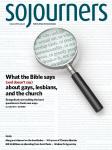IF WE FOLLOWED the church calendar and celebrated Epiphany in January, we wouldn’t have to cram the wise men into the crèche to compete with the shepherds. We could save all the “Star of Bethlehem” songs to brighten the cold days of January. Obviously, the magi needed a few weeks to prepare and then travel “from the East.”
A new bright object in the sky was certainly an “epiphany,” but it was not totally unexpected. These magi were astrologers, the ancient astronomers of their day. To the east of Jerusalem lay Babylon, birthplace of astrology and location of a large Jewish community. The discovery of two astrological books among the Dead Sea scrolls showed that the sign of Aries the Ram in the zodiac represented the reign of Herod the Great in Judea. Since Herod was aging, it is not surprising that Jewish astrologers were watching this royal constellation.
In a television series called Jesus: The Complete Story, astronomer Michael R. Molnar notes an unusual astrological conjunction on the night of April 17, in 6 B.C.E., the year Jesus was most likely born. At that time, both Saturn and the sun were in the constellation Aries, and then the moon eclipsed to reveal Jupiter, king of the planets, also in Aries. Jupiter shone into the dawn, another auspicious sign of royalty. It was confirmation enough to send these astrologers on their way.
Perhaps if we celebrated Epiphany after Christmas, we’d have more time to learn about this epiphany and its remarkable interpretation.
[January 4]
Who Recieves the Blessing
Jeremiah 31:7-14; Psalms 147:12-20; Ephesians 1:3-14; John 1:1-18
HAS THE JOY of Christmas worn off a bit? The farther north we live, the colder are the days, and the higher the heating costs—along with credit-card bills coming due from holiday celebrations. Although Psalm 147 honors winter in poetic lines where Yahweh “gives snow like wool; scatters frost like ashes. God hurls down hail like crumbs” (verses 16-17). A better reading for this week may be from the Lord’s Prayer: “Forgive us our debts.”
Instead, our four readings from four different contexts brim with gratitude and praise. The prophet Jeremiah imagines the returning Jewish exiles singing “aloud on the height of Zion” (31:12). He even remembers “the blind and the lame, those with child and those in labor, together ... with consolations I will lead them back” (31:8-9).
Within these texts, however, are two opposing assumptions about the recipients of God’s bounty. Who are they?
In Jeremiah 31, Yahweh has only “ransomed Jacob” and has “become a father to Israel, and Ephraim is my firstborn.” Psalm 147 is even more exclusive: God “declares his word to Jacob, his statutes and ordinances to Israel. [God] has not dealt thus with any other nation” (verses 19-20).
But in John 1, the emphasis shifts. The eternal Word now embodied in flesh came to “what was his own, and his own people did not accept him” (verse 11). Only those who receive him as their own are given “power to become children of God” (12). From now on, having the right genealogy won’t cut it.
When it comes to spiritual blessings, Ephesians 1 is truly lavish. We have “redemption” as God’s own people, “forgiveness of sins,” a great inheritance, and “the seal of the promised Holy Spirit.” But this text does not clarify who “we” are. Not until Ephesians 2 do we find out that these blessings are also for non-Jews, originally “aliens from the commonwealth of Israel” (verse 12). The dividing wall between Jew and Gentile is now demolished. This Sunday, let’s ponder not only God’s generosity, but also changing attitudes about who receives it.
[January 11]
Water, Spirit, Power
Genesis 1:1-5; Psalm 29; Acts 19:1-7; Mark 1:4-11
THE WORDS “WATER, power, creativity, and Spirit” tie our four texts together. Narrative poetry in Genesis 1 portrays a dark, watery void upon which the Spirit of God moves to create light and our living earth. Psalm 29 magnifies this power: “the God of glory thunders, the Lord, over mighty waters” (verse 3)!
The readings from Mark 1 and Acts 19 focus on water used for baptism—and again the Spirit hovers over that water. John’s baptism left quite an impact. Some years later and many miles away in Ephesus, Paul finds a dozen disciples who only know the baptism of John. When Paul re-baptizes them in the name of Jesus, the Holy Spirit comes upon them.
As our earliest gospel, Mark is quite clear that when John baptized Jesus, the Spirit descended on him to proclaim him God’s beloved. Yet Mark also matter-of-factly states something that proves embarrassing for the growing Jesus Movement. John was proclaiming a “baptism of repentance for the forgiveness of sins” (1:4). Yet he never blinks an eye when Jesus comes to him to be baptized. Did Jesus also need to repent of sin?
The other three gospel authors squirm uncomfortably at this thought. In Matthew, John confronts Jesus with the dilemma, but Jesus responds ambiguously, “Let it be so now, for it is proper in this way to fulfill all righteousness” (Mathew 3:15). Luke repeats Mark’s description of John’s baptism as a sign of repentance and forgiveness (Luke 3:3), but later casually mentions that Jesus was baptized while praying, never mentioning John’s role (3:21). In the fourth gospel, John affirms his role as baptizer, but does not name it as a symbol of repentance, nor does he baptize Jesus. When Jesus shows up, John names him as the Lamb of God who takes away sin (John 1:29)!
Since these retellings minimize Jesus’ baptism as one of repentance, we can deduce that Mark’s account is authentic. So deeply does the human Jesus identify with us.
[January 18]
Unexpected Appearances
1 Samuel 3:1-20; Psalm 139:1-6, 13-18;1 Corinthians 6:12-20; John 1:43-51
JANUARY 6 WAS the feast of Epiphany, the 12th day of Christmas, which celebrates the visit of the magi “from the East.” Let’s take a moment on this second Sunday after Epiphany to define this Greek word we rarely use. The verb epiphainō simply means “to show oneself” or “to make an appearance.” The noun epiphaneia is “an appearing.” For members who rarely attend church, their presence on Christmas or Easter may truly be “an epiphany”!
In religious contexts, however, my Greek lexicon calls an epiphany “a visible manifestation of a hidden divinity, either in the form of a personal appearance, or by some deed of power.” To those Eastern astrologers that unusual star beckoning them to seek a new king in Judea was indeed an epiphany.
Two of our readings describe other divine epiphanies. Before Israel’s monarchy, the last and greatest judge over the people was Samuel. Yahweh had blessed Hannah, Samuel’s devout mother, with a son, whom she dedicated back to God. So as a young boy, Samuel lived with the old priest Eli at Shiloh, a sacred site in Samaria housing the Ark of the Covenant. But “the word of the Lord was rare in those days; visions were not widespread” (1 Samuel 3:1). One night Samuel heard a voice calling him. Thinking it was Eli, he went to him three times, until Eli finally realized this was a divine epiphany. Samuel responded to the Lord, who confirmed an oracle of judgment upon Eli’s wayward sons.
More than 1,000 years later, a Galilean Jew from the town of Bethsaida also had an unexpected epiphany. Inconsequential at first—the rabbi Jesus noticed Nathanael sitting under a fig tree. Yet an instant spiritual connection between these two resulted in a special revelation from Jesus: “You will see heaven opened and angels of God ascending and descending upon the Chosen One” (John 1:51), hearkening to the vision of Daniel (7:9-14). Do such epiphanies happen today? What’s your experience?
[January 25]
Preparing for a New Future
Jonah 3:1-5, 10; Psalm 62:5-12; 1 Corinthians 7:29-31; Mark 1:14-20
“THE FORM OF this world is passing away,” warns Paul in 1 Corinthians 7. So also insist environmental scientists, who warn of an unlivable planet unless we can control our carbon emissions. Today’s climate-deniers remind me of the people who jeered at Noah building a boat on dry land.
Although Noah’s story is not one of our readings, three other texts warn of radical changes to come. The reign of God—and thus the judgment of God—is imminent. Repent and prepare for a different future! For Mark and Paul, the coming of Messiah Jesus is good news; Jesus announces the arrival of God’s reign on earth (Mark 1:15). But this also demands repentance and lifestyle changes. Jesus’ call to Peter, Andrew, James, and John represents the radical vocational change that this response requires (Mark 1:16-20).
The Apostle Paul’s own vocation changed drastically as well, and he preaches the same message to believers in Corinth who were still enmeshed in “this world” behaviors. Verses 29-31 summarize Paul’s advice to believers in various nuanced ways as to how their lifestyles should change (or stay the same) regarding marriage, social status, or male circumcision. The admonition to “those who buy as if they had no possessions” especially challenges our current materialistic society.
But perhaps upright, law-abiding church people, identify most with the prophet Jonah’s dilemma. We struggle to live godly lives—and then what if our worst, nastiest enemies do repent? Can we handle God’s forgiveness of people we love to hate? Finally, Psalm 62 describes the rest that comes to those who have let go of the “passing form of this world.” The psalmist reminds, do not set your heart on high or low status because power and steadfast love belong to God (see verses 10-12). Wait, instead, for God alone. God alone is your rock and salvation.
“Preaching the Word,” Sojourners’ online resource for sermon preparation and Bible study, is available at sojo.net/ptw.

Got something to say about what you're reading? We value your feedback!
